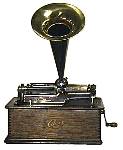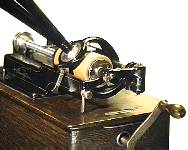Wax Cylinder Records

Two-minute wax cylinders.
Photo credit 5.
By 1888, a cylinder record standard had emerged;
it had shrunk in size to a little over 2" in diameter
and 4" long, was made of a usually brownish wax-like
material – and it was brittle.
Early wax cylinder recording speeds varied; slower speeds
such as 90-RPM, used often for spoken material, would yield
nearly a 4-minute recording, while faster speeds from 120
to 160-RPM (or more) for music would run for around 2 to
2½ minutes.
In the late 1890's, recording speeds were typcially in
the 120 to 125-RPM range, but by 1902 had settled into
a standard 160-RPM.
Please note:
Click on the images to see a full-sized view.
The Columbia Phonograph Company made cylinder records until 1909
when it dropped cylinders in favor of disk records (see note 1).
The Victor Talking Machine Company never sold cylinder records,
preferring the disk format.
Edison's National Phonograph Company continued making wax cylinders
until late 1912 (when they switched from using wax to a celluloid plastic).
Edison finally stopped making all entertainment records, both cylinder
and disk, in October 1929 – one day before the stock market crash.



 Copyright (C) (P) 1996-2024 Glenn Sage, Portland, Oregon. All Rights Reserved.
Contacting Tinfoil.com.
Copyright (C) (P) 1996-2024 Glenn Sage, Portland, Oregon. All Rights Reserved.
Contacting Tinfoil.com.



